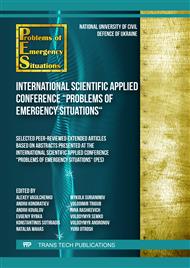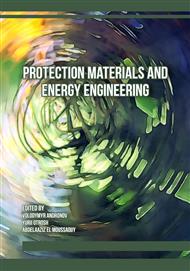p.135
p.145
p.157
p.167
p.177
p.185
p.195
p.201
p.211
Substantiation of the Swellable Coating Effectiveness for Fire Protection of Wooden Constructions
Abstract:
As a result of the studies of wood flame retardant effect on ignition, the parameters of flame propagation and combustion suppression were established, which makes it possible to influence this process. It has been proven that the creation of a protective layer on the surface of wood prevents it from heating up to a critical temperature. At this moment, a certain amount of combustible gases is released, that is, intense decomposition and ignition occurs. This knowledge makes it possible to establish the dependence of the process of inhibiting the burning rate of wood on the quality of fire protection and the properties of the applied protective mixtures. By experimentally examining wood samples, it was established that the sample without treating caught fire on 52 s and in 100 seconds the flame spread over the entire surface, the sample fire-retardant "FIREWALL-ATTIK" did not catch fire, impregnating solution ВС-13 and "FIREWALL-SV-1", namely a mixture of 271.1 g/m2, took 570 and 560 s, the flame spread to the surface only in areas closer to the source, the highest flue gas temperature of 86 and was reached more than 5 times faster, and the flammability index decreased to 4. For the sample protected by "FIREWALL-LAC" ignition occurred in the last second, the flame was recorded at level 0. For the sample fire-protected by "FIREWALL-WOOD" coating no ignition occurred, combustibility index is 0. Due to this, it became possible to determine the conditions for changing the combustion barrier to heat conductivity. Correspondence between the obtained experimental results of the wood burning rate and the analytically calculated equations was found.Taking into account the above, there is a basis for asserting the possibility of purposeful management of the processes of protecting wood from fire by applying fire-retardant mixtures, which under certain conditions are able to create a protective layer on the surface of the material, which restrains the growth of the rate of wood burning.
Info:
Periodical:
Pages:
211-217
Citation:
Online since:
August 2023
Price:
Сopyright:
© 2023 Trans Tech Publications Ltd. All Rights Reserved
Share:
Citation:



